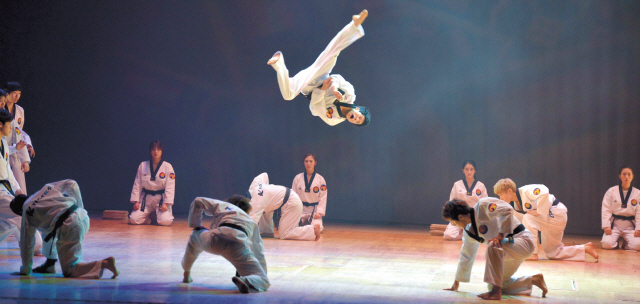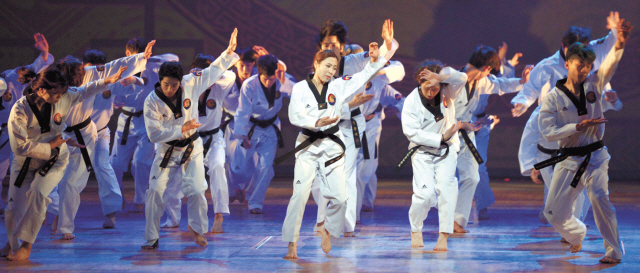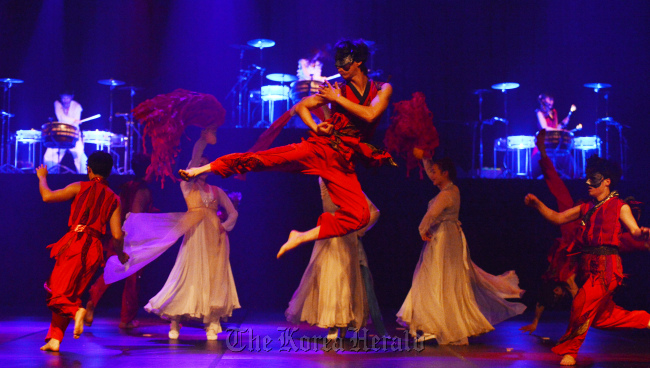Taekwondo high-kicks into performance art
A harmony of technical martial art combined with musical flair
By Korea HeraldPublished : Jan. 25, 2013 - 20:44
Transcending into the realm of modern performance art, the Korean marital art of taekwondo has graduated beyond being just a method of self-defense and a combat sport.
Taekwondo can now be considered a spectacle of artistic and musical integrity.
The World Taekwondo Federation estimates that there are approximately 70 million practicing taekwondo athletes around the globe, making it one of the world’s most practiced martial arts.
With its increasing popularity, due largely to its induction into the Olympics in 1988, the incorporation of taekwondo in performance shows is adding a fresh and energetic acrobatic burst of energy to otherwise musical acts.
Taekwondo can now be considered a spectacle of artistic and musical integrity.
The World Taekwondo Federation estimates that there are approximately 70 million practicing taekwondo athletes around the globe, making it one of the world’s most practiced martial arts.
With its increasing popularity, due largely to its induction into the Olympics in 1988, the incorporation of taekwondo in performance shows is adding a fresh and energetic acrobatic burst of energy to otherwise musical acts.


Nonverbal performances have been gaining a lot of popularity in Korea and the number of shows in this style has been on the rise. Shows such as “Jump,” “Bibap,” “Fanta-Stick,” “Y-Kick,” “K-Tigers” and many others combine the techniques of traditional taekwondo with acrobatics, hip-hop choreography and b-boying to create modern-day martial arts productions.
The art of taekwondo
“TAL: The Legend of Korea Extreme Taekwondo Performance” is one such nonverbal taekwondo performance show that brings together a variety of aspects of Korean traditional and modern culture of martial arts, dance and music.
“Taekwondo is more recognizable than Korea,” said Choi So-ri, executive director of “TAL.”

As a percussionist for the past two decades, Choi has been around the world holding performances in more than 100 countries. However, during his worldly experiences meeting people from different nations, he had an epiphany to combine the energetic nature of his percussion performances with the thrills and discipline of taekwondo.
“Few understood this energy was Korean and that the music that I played for them was Korean,” he said. “It was then that I began thinking about creating a performance which combined Korean music and taekwondo ― the two aspects of Korean culture which I felt resonated best with foreign audiences.”
This is how the taekwondo-based musical performance group of “TAL” came into being.
The show is filled with high-flying acrobatics with the taekwondo athletes jumping, spinning, twirling and flipping all the while shattering wooden boards with their bare hands and feet. There are also spectacular percussion performances, from water splashing up from the top of the drums while they’re being beaten, to the wildly energetic playing of the drums with flame-lit drum mallets, bound to make one’s heart pound along with the beat.
“TAL,” which means “mask” in Korean, is based on a traditional Korean dance genre known as the mask dance. It is not intended to be a representation of hiding oneself, but rather the ability to express and evoke human emotions.
“‘TAL’ combines the similarities of taekwondo and the mask dance to emphasize the importance of mental and physical training,” said Choi.
The nonverbal performance tells the story of the moral conflict between two friends in a battle of good versus evil. One friend, who is kind and loyal, expresses a desire to use what he has learned in order to maintain life in keeping with the taekwondo spirit, while the other friend becomes filled with greed and wishes to use his powers to reign and rule over others. The storyline also includes tales of love, tradition, culture and Korean spiritual mythology.
“Taekwondo is no doubt a martial art, but its spiritual foundations are rooted in the ideals of peace and equality,” said Choi. “This can be seen from the fact that taekwondo is based on defensive rather than offensive moves.”
“TAL” is an energetic and active live performance that finds a balance between both the aspects of taekwondo as a martial art and as an artistic musical performance.
Along with the acrobatics, the show combines both elegantly performed traditional Korean dancing and modern-day, straight-from-the-streets b-boy style dancing. The wide variety and unique combinations of musical performance elements make the show hip, current and capable of catering to a larger and more general audience.
“I want to add some exciting and youthful energy to the show,” said “TAL” b-boy dancer Jung Min-hyuk. “For this show, we wanted to combine all different aspects of Korean culture for people to enjoy.”
Aside from its modern twist on martial art as a musical performance piece, the core of “TAL” is still deeply rooted in historical techniques of taekwondo. Yet, the performance still emphasizes its mixing bowl of various elements of Korean culture, such as traditional Korean dancing and percussion music.
“Through the beat of my drums, I hope to capture the audiences’ attention and keep them focused on its sound,” said pop artist and percussionist Miso Kim.
“And through taekwondo we hope to express its strength, gentleness and tolerance,” said “TAL” taekwondo performer Kang Hun-jik. “I believe our show helps open the doors of taekwondo and gives the audience, both young and old, an easier access to see and enjoy the sport.”
Last year the members of “TAL” performed all around the world including in France, Spain, England, Belarus, Switzerland, Singapore, and China. The world tour group of “TAL,” currently in its third year running, is now holding extended performances in Seoul for the very first time. The first show was held on Thursday and will continue every day until March 24 in the K-Art Hall at the Seoul Olympic Park.
Taekwondo master An Byeong-cheol, who runs the International Kumgang Taekwondo Center, pointed to the importance of taekwondo performances such as “TAL” in terms of its role in furthering the image and recognition of the martial art outside of Korea.
“These kinds of shows are very important. They have really created a marketable product,” he said. “We need more of this kind of performances because they help spread the understanding of taekwondo around the world.”
Origin of the weaponless technique
Taekwondo is thought to have originated during the Three Kingdoms period on the Korean Peninsula. Historical records show that young warriors of the Silla Kingdom (B.C. 57-A.D 935), called hwarang, practiced a martial art form that is the progenitor of today’s taekwondo.
Taekwondo evolved through time until it was formalized into its modern form and popularized following the Korean War.
Unlike many other forms of martial arts, taekwondo is best known for being a weaponless method of fighting. The term taekwondo is broken up into three separate terms: “tae” meaning foot, “kwon” meaning fist and “do” meaning way or method. When combined, the term loosely translates to “the way of the foot and fist.”
In terms of fighting techniques, kicks are especially emphasized in taekwondo because the leg is more powerful than the arm in terms of strength. Taekwondo masters rationalized that kicking has the greater potential to inflict the most pain with more powerful strikes than a fist.
Master An shared the story about how Bruce Lee, one of the most iconic worldly figures when it comes to the subject of martial artists, learned and trained in the art of kicking from Korean taekwondo grandmaster Jhoon Rhee. Rhee is often referred to as the “Father of American taekwondo” for his role in introducing the martial art to the United States in the 1950s.
“When you watch a lot of Bruce Lee movies, the scenes where he is performing various kicking combinations ... he learned that from taekwondo,” said An.
“Taekwondo is very scientific. There are more than 2,500 different kinds of kicks,” he said. “However, many foreigners, when they think about taekwondo, when they see it in the Olympics, they think that it is only about kicking and that’s just not true.”
Although taekwondo is known for its emphasis on kicking ― which is one of its distinguishing features compared to other martial arts such as karate or kung fu ― it does have a myriad of offensive and defensive hand formations and movement techniques that are in every intent meant to inflict serious injury, and at times, even death.
“One of the main reasons why kicks, as opposed to hitting or jabbing, are used during taekwondo events in the Olympics is because it is considered to be less dangerous,” said An. “The purpose of these types of sporting events is for enjoyment and competition, not to intentionally hurt your opponent.”
Taekwondo demonstrates the techniques needed for optimal kicking and punching strength. However, the martial art techniques of taekwondo are based on Taoism and are deeply rooted in the concepts of spiritual discipline. It serves not only defensive purposes, but also as a means to provide people with a state of mental equilibrium.
“One of the most important aspects of taekwondo is focus and manners,” said An. “Taekwondo is about mastering patience, perseverance and most importantly, about being able to be in control of your mind.”
By Julie Jackson (juliejackson@heraldcorp.com)
-
Articles by Korea Herald



















